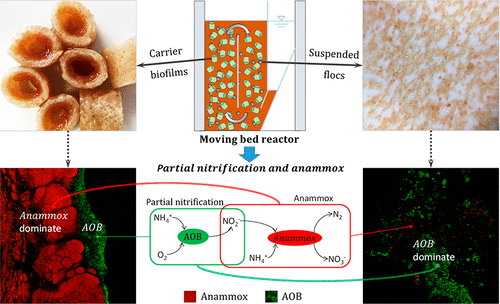当前位置:
X-MOL 学术
›
ACS Sustain. Chem. Eng.
›
论文详情
Our official English website, www.x-mol.net, welcomes your feedback! (Note: you will need to create a separate account there.)
Using Partial Nitrification and Anammox To Remove Nitrogen from Low-Strength Wastewater by Co-immobilizing Biofilm inside a Moving Bed Bioreactor
ACS Sustainable Chemistry & Engineering ( IF 8.4 ) Pub Date : 2018-12-09 00:00:00 , DOI: 10.1021/acssuschemeng.8b05055 Rong Chen 1, 2 , Yasuyuki Takemura 2 , Yuan Liu 2 , Jiayuan Ji 2 , Satoshi Sakuma 2 , Kengo Kubota 2 , Haiyuan Ma 2 , Yu-You Li 2
ACS Sustainable Chemistry & Engineering ( IF 8.4 ) Pub Date : 2018-12-09 00:00:00 , DOI: 10.1021/acssuschemeng.8b05055 Rong Chen 1, 2 , Yasuyuki Takemura 2 , Yuan Liu 2 , Jiayuan Ji 2 , Satoshi Sakuma 2 , Kengo Kubota 2 , Haiyuan Ma 2 , Yu-You Li 2
Affiliation

|
The stable operation of partial nitrification and anammox (PNA) process is a challenge in nitrogen removal from extremely low-strength ammonia wastewater like sewage mainstream. A moving bed reactor with functional carriers (30% filling rate) was developed to treat a synthetic influent with 50 mg/L ammonia. The long-term operation results showed nitrogen removal efficiencies of 71.7 ± 9.1% have been stably obtained under a relatively short hydraulic retention time of 2 h. Microbial analysis revealed anammox bacteria and ammonium oxidizing bacteria (AOB) with 29.7% and 6.32% abundance were the two most dominant bacteria in the reactor. Carriers largely retained slow-growing anammox bacteria in their hollow space and established a sandwich-like biofilm structure of co-immobilization of anammox bacteria and AOB. The anammox activity was much higher in carrier biofilms than in suspended flocs, while, for the AOB activity, the situation was reversed. Correspondingly, a fluorescent in situ hybridization analysis illustrated the active cell fractions of anammox bacteria and AOB in carrier biofilms were 63.7% and 4.8%, and 2.7% and 61.4% in suspended flocs. Biofilm formation and dissolved oxygen control were deemed to be the two key factors affecting the optimal co-immobilization of anammox bacteria and AOB, which guaranteed the efficient PNA.
中文翻译:

使用部分硝化和厌氧氨氧化技术通过将生物膜共同固定在移动床生物反应器中来去除低强度废水中的氮
部分硝化和厌氧氨氧化(PNA)工艺的稳定运行对从污水处理主流这样的极低强度氨废水中脱氮来说是一个挑战。开发了带有功能性载体(填充率30%)的移动床反应器,以处理含50 mg / L氨的合成进水。长期运行结果表明,在相对较短的2 h水力停留时间下,稳定地获得了71.7±9.1%的脱氮效率。微生物分析显示,具有29.7%和6.32%丰度的厌氧氨氧化细菌和铵氧化细菌(AOB)是反应器中两个最主要的细菌。携带者在其空心空间中很大程度上保留了缓慢生长的厌氧细菌,并建立了将厌氧细菌和AOB共同固定的三明治状生物膜结构。载体生物膜中的厌氧氨氧化活性比悬浮的絮状物高得多,而AOB活性则相反。相应地,荧光原位杂交分析表明,载体生物膜中的厌氧细菌和AOB的活性细胞分数分别为63.7%和4.8%,在悬浮的絮凝物中为2.7%和61.4%。生物膜的形成和溶解氧的控制被认为是影响厌氧细菌和AOB最佳共固定化的两个关键因素,这保证了有效的PNA。
更新日期:2018-12-09
中文翻译:

使用部分硝化和厌氧氨氧化技术通过将生物膜共同固定在移动床生物反应器中来去除低强度废水中的氮
部分硝化和厌氧氨氧化(PNA)工艺的稳定运行对从污水处理主流这样的极低强度氨废水中脱氮来说是一个挑战。开发了带有功能性载体(填充率30%)的移动床反应器,以处理含50 mg / L氨的合成进水。长期运行结果表明,在相对较短的2 h水力停留时间下,稳定地获得了71.7±9.1%的脱氮效率。微生物分析显示,具有29.7%和6.32%丰度的厌氧氨氧化细菌和铵氧化细菌(AOB)是反应器中两个最主要的细菌。携带者在其空心空间中很大程度上保留了缓慢生长的厌氧细菌,并建立了将厌氧细菌和AOB共同固定的三明治状生物膜结构。载体生物膜中的厌氧氨氧化活性比悬浮的絮状物高得多,而AOB活性则相反。相应地,荧光原位杂交分析表明,载体生物膜中的厌氧细菌和AOB的活性细胞分数分别为63.7%和4.8%,在悬浮的絮凝物中为2.7%和61.4%。生物膜的形成和溶解氧的控制被认为是影响厌氧细菌和AOB最佳共固定化的两个关键因素,这保证了有效的PNA。


























 京公网安备 11010802027423号
京公网安备 11010802027423号